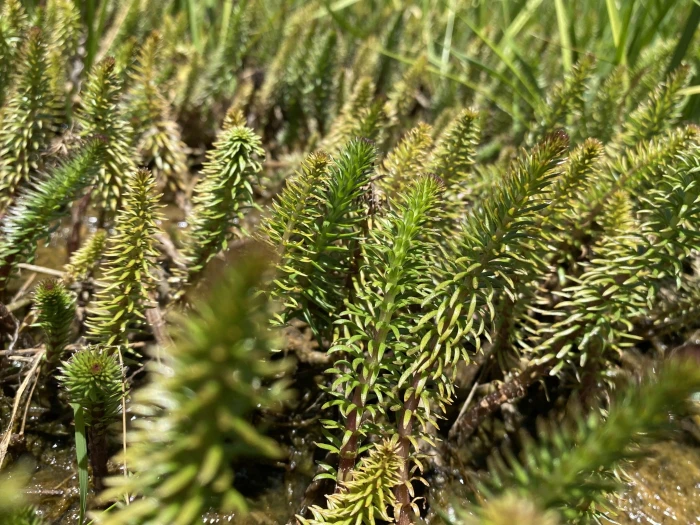Common Mare’s-Tail
(Hippuris vulgaris)
Common Mare’s-Tail (Hippuris vulgaris)
/
/

Matt Berger
CC BY 4.0
Image By:
Matt Berger
Recorded By:
Copyright:
CC BY 4.0
Copyright Notice:
Photo by: Matt Berger | License Type: CC BY 4.0 | License URL: http://creativecommons.org/licenses/by/4.0/ | Rights Holder: Matt Berger | Publisher: iNaturalist | Date Created: 2020-06-23T20:21:58Z |











































Estimated Native Range
Climate Requirements for Antwerpen, Belgium
| This Plant | Your Site | Plant Suitability for Your Location | ||
|---|---|---|---|---|
| • Precipitation | 2" - 152" | 32" | Your precipitation may be insufficient for this plant. Irrigate N" / year. | Irrigate N" / year |
| • High Temp. | 12°F - 97°F | 74°F | Your summer temperatures are normal for this plant. | Excellent |
| • Low Temp. | -56°F - 56°F | 34°F | Your winter temperatures are normal for this plant | Excellent |
This plant should grow well at your location with about N inches per year (Y minutes per month) of irrigation.
Summary
Hippuris vulgaris, commonly known as Common Mare’s-tail, is an aquatic perennial herb native to a wide range of habitats including marshes, ditches, and the shallow edges of ponds and lakes, primarily in non-acidic waters across Eurasia and North America, from Greenland to the Tibetan Plateau and Arizona. It typically projects stems 8-12 inches above the water’s surface, with the rest of the plant submerged, and can spread to form dense colonies. This plant is characterized by its simple, linear leaves that whorl around the stem, resembling a horse’s tail, and it lacks conspicuous flowers, relying on wind and water for pollination.
Common Mare’s-tail is valued for its use in water gardens and ponds for its oxygenating properties and as a habitat for aquatic wildlife. It is easy to maintain, requiring minimal care once established in a suitable aquatic environment. However, it can become invasive outside its native range, so it is crucial to check local regulations before planting. In cultivation, it prefers full sun to part shade and can tolerate a range of water conditions, from standing water to periodically wet soil.CC BY-SA 4.0
Common Mare’s-tail is valued for its use in water gardens and ponds for its oxygenating properties and as a habitat for aquatic wildlife. It is easy to maintain, requiring minimal care once established in a suitable aquatic environment. However, it can become invasive outside its native range, so it is crucial to check local regulations before planting. In cultivation, it prefers full sun to part shade and can tolerate a range of water conditions, from standing water to periodically wet soil.CC BY-SA 4.0
Plant Description
- Plant Type: Herb
- Height: 0.3-2 feet
- Width: 0.7-2 feet
- Growth Rate: Moderate, Rapid
- Flower Color: Green
- Flowering Season: Spring, Summer
- Leaf Retention: Evergreen
Growth Requirements
- Sun: Full Sun, Part Shade
- Water: High, Aquatic
- Drainage: Standing
Common Uses
Low Maintenance, Water Garden
Natural Habitat
Marshes, ditches, and the shallow edges of ponds and lakes in non-acidic waters
Other Names
Common Names: Mare’s Tail, Horse Tail, Pinito De Agua
Scientific Names: Hippuris vulgaris, Caullinia hippuroides, Hippuris eschscholtxii, Hippuris eschscholtxii, Hippuris eschscholtzii, Hippuris eschscholtzii, Hippuris eschscholtzii, Hippuris fluitans, Hippuris fluitans
GBIF Accepted Name: Hippuris vulgaris